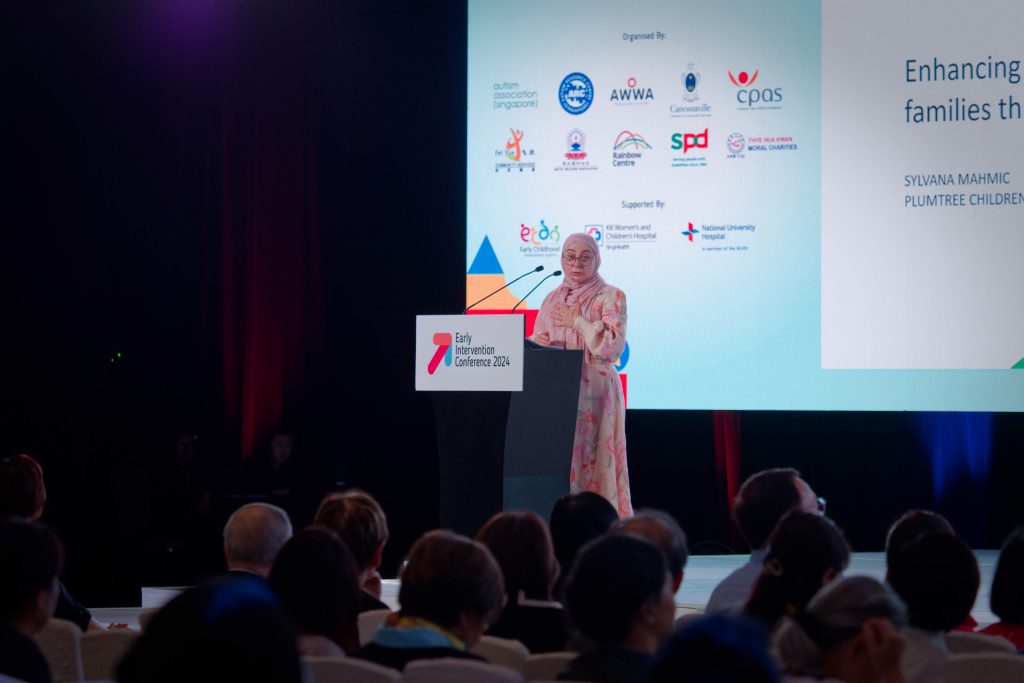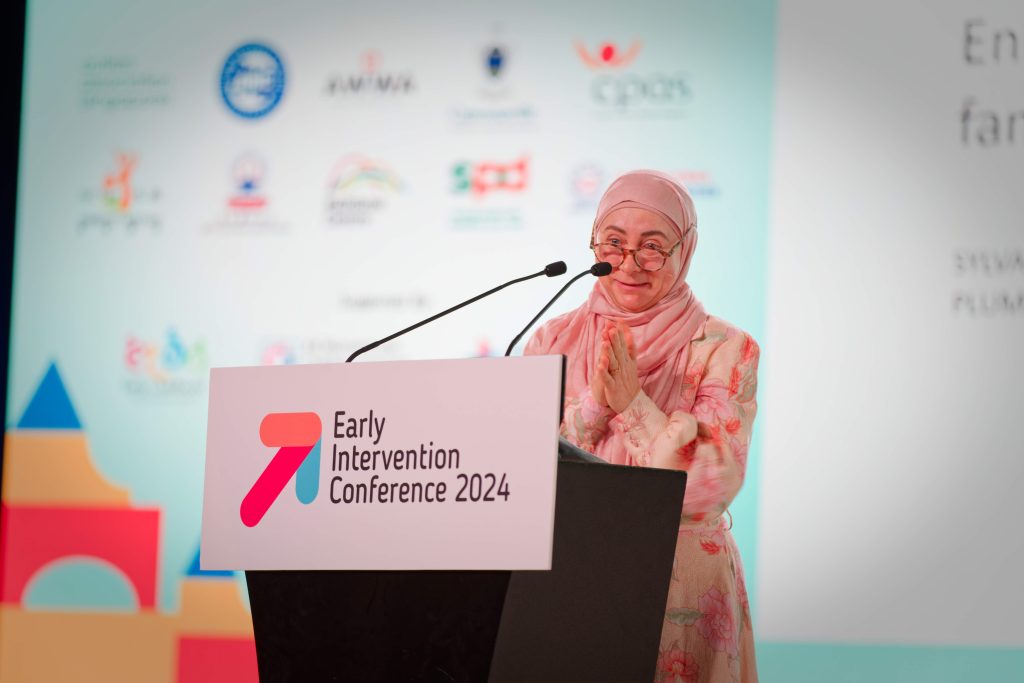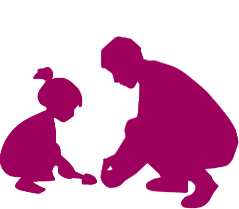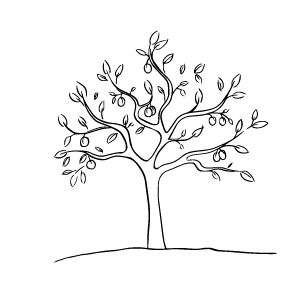This post contains the keynote address given by Sylvana Mahmic, Plumtree CEO at the Singapore Early Intervention Conference on April 26th, 2024.
Thank you, Minister Masagos Zulkifli, guests, and delegates.
It’s a pleasure to be here in Singapore for your early childhood intervention conference and it is phenomenal to see over 1,200 delegates here today. Thank you for your invitation to share my research and insights on enhancing outcomes for children and families through team collaboration. But before we begin, I would like to share a personal story that has deeply influenced my journey in the field of early childhood intervention.
My eldest son Karim, now 34 years old, was born with cerebral palsy and intellectual disability. He attended a mainstream preschool and primary school, followed by a support class at his local high school. To our family, he is a confident, artistic, community-minded person with a passion for advocating for the rights of people with disabilities. Yet he has faced a world that often underestimated his abilities.
Karim’ story—in pictures
Karim and his team have written a graphic novel, called Karim’s Mojovational Disco, which is a coming-of-age story that he uses to challenge society’s expectations of people with a disability.
After high school, the paths offered to him were extremely limited to segregated day care options. He made it clear to us that this option wasn’t for him. Instead, he wanted to do martial arts. He communicated this to us by gestures.
So, choosing to focus on his strengths and interests rather than his challenges, we, as his family, set about making this happen so that he could live his best life.
We made calls to several martial arts schools, but we faced closed doors. The beliefs of those in the community were that disability was a problem that they didn’t have the skills or inclination to consider.
A paradigm shift: from deficits to strengths
Our society often views disabilities through a lens of limitations, focusing solely on what individuals cannot do rather than their strengths. Many parents hold these views as well because these beliefs are so common in society. We call this a deficit-focused paradigm, the dominant lens through which we view disability. It’s therefore understandable that parents hold these views too.
This is because most parents, like many others in our society, may not have had any experience of disability. Also, parents are still learning about their child’s development and adjusting to a life that they were not expecting in these early years. For these reasons, it’s likely that parents view disability as a disadvantage and believe that it is the experts that know best, which in turn influences parent–professional collaboration.
This deficit-focused paradigm can also undermine a child and their family’s confidence and wellbeing. We found in one of our studies that we could challenge this by creating a strengths-focused intervention. It leads to a positive shift in family confidence that makes them more collaboration ready.
We used a systems-informed positive psychology approach to focus on strengths and what was possible. This intervention shifted the family’s perceptions of disability as a disadvantage, and experts know best, to a perception that they can start with their strengths, have the confidence to look after themselves, and see the potential for positive progress.
In this illustration summarising our research, we see examples of how parents spoke when influenced by a deficit system: ‘Assess my child, find the gaps, and fix them’, with parents asking professionals to tell them what to do and professionals giving them prescriptive advice. However, these parents changed after we introduced them to a strengths-focused, co-designed intervention based on positive psychology.
Their shift in thinking was reflected in their language around strengths and wellbeing, for example, ‘I have a plan and my goals are achievable, I am powerful, I believe in myself’ and ‘I changed as a mother’. The results suggested that parents started focusing more on their strengths and felt more hopeful, empowered, and engaged. These characteristics get parents collaboration ready. For more information on this research, the peer-reviewed article are below and available for free.
Why should it matter that families shift to a strengths-focused paradigm and feel empowered and collaboration ready?
Crossing a bridge to a good life
Let’s imagine a bridge that families cross, beginning in their child’s early childhood years and extending until they turn 18 years old.
On the left, they meet early childhood intervention professionals, medical and diagnostic professionals, community organisations and other services.
On the right-hand side, as children reach 18, we all hope to see confident young adults who achieve as much independence as their abilities allow accepted by their communities. They live lives as citizens filled with purpose.
Everyone should provide messages of hope and potential, from the very start to get families onto this bridge.
The family that is the constant in the child’s life. They will be guiding their child’s life journey at least until they are 18 years old, long after early intervention professionals have gone from their lives. Our time with parents is a relatively short period as we can see in this infographic.
Many parents want a good life for their children as they grow and become adults. But most don’t know how to get there. They need signposts to know where they are headed.
Some families manage to navigate their way quickly on their own. However, many are uncertain of how to reach the other side, or even know that there is another side—a life of independence, acceptance and purpose.
When children are little, big-picture visioning is important for the future. For some parents, it can take many years for this idea and a plan to even take shape.
Our role in the early years is to help families step onto this bridge. By modelling collaborative partnerships, we provide families with a foundation to navigate the bridge without us in the future.
Once on the bridge, there are three laneways of support:
1. Community inclusion. Communities and being a part of a community are vital for families, as inclusion is a core principle in intervention. Experiencing and participating in activities outside of the home helps pave the way for children to become independent, capable and self-fulfilled adults.
2. Peer-led organisations and networks. With lived experience raising a child with disability or developmental difference, these networks provide valuable knowledge and perspective that complement specialist services. Peer leaders help families on the bridge to explore more ambitious possibilities.
3. Specialist services when needed. Therapy is usually foremost on parents’ minds. While important, parents need to know that there is more to disability support than therapy and formal services. These services are helpful when needed but shouldn’t dominate the lives of children and families.
Over the next eighteen years, parents will use these three laneways as required for their journey ahead. They will move between the laneways as needed, enhancing their skills to build a good life for their children, and to ensure the whole family keeps moving forward on the bridge.
While on the bridge, families can be linked to other parent-peer and family-led organisations. Having gained more insight, they will be more prepared and open to value the benefits that these organisations offer.
Being a parent can be challenging, but strengths-based approaches rooted in positive psychology help families continue learning, recharge, and maintain momentum to keep moving in the right direction on the bridge.
Navigating the bridge
Let’s get practical: are each of the three laneways easy for families to travel in?
In Australia, the NDIS has transformed the specialist support laneway into a super-fast freeway—no wonder families jump into this laneway and stay there. However, the inclusion and peer-led laneways are dusty, bumpy, and slow, making them more challenging to navigate.
In Australia, this hypothetical bridge will require investment for capacity-building initiatives involving family leadership, peer work and education to keep families on the bridge and moving between the laneways. I invite you to consider the condition of these three laneways here in Singapore and hope this analogy helps you think about potential system changes for the future.
More can be done by the community and government to enable further support during the journey. Investment is needed for initiatives to help mothers, fathers, caregivers, siblings and the child. We need to make this bridge wider and stronger.
Because at the destination, these empowered families will thrive, and more. They will build the future. They will create ways for other families to cross the bridge to a good life.
By embracing a systemic hopeful approach rooted in positive psychology, we can instill a sense of optimism in families from the very beginning. This investment approach not only fosters resilience. It reduces the risk of family breakdown and social isolation, which is a terrible outcome for society and expensive for government.
Nurturing the child’s voice and independence
Navigating the journey of supporting a child with disabilities throughout the 18 years is a profound experience for families. During this time, not only do they move between the three laneways as I have described, but they also have the crucial task of fostering their child’s independence through amplifying their choice and voice.
As typically-developing children grow from infancy to young adulthood, the dynamics of decision-making within families evolve. Initially, parents significantly guide their child’s choices, offering options like what to drink or which story to read. However, as children mature, parents gradually relinquish control, allowing their child to exercise increased autonomy over their decisions.
For parents of children with disabilities, this process can be more complex. Parents may inadvertently limit the child’s choices due to their preconceived notions about their capabilities and risks. Such assumptions can restrict children’s opportunities to experience autonomy and independence.
This is why parents need the bridge, to help them see the long-term goals for their child and family’s future and use the three laneways to get there.
So, what does this look like in action?
I would like to share how we at Plumtree in Sydney, Australia, have taken concrete steps to translate these beliefs into action and create new ways to collaborate with families.
We operate from a family-centered model, where families are empowered to make decisions and leverage their strengths to support their child’s development. Professionals view families as partners, working collaboratively to achieve common goals.
Theory of change: building family capacity through participation
Guiding our work at Plumtree is a theory of change rooted in positive psychology, family leadership, and a strength-based approach. A theory of change is like a roadmap that explains where we want to go and how we will get there.
We prioritise building family capability through active participation, so parents are collaboration ready. To achieve this, we codesigned Now and Next, a by-families for-families program in 2015. We also increased parent engagement in planning with Pictability, a new resource we developed, and we trained and employed parent-peer workers and leaders.
Now & Next development began in 2015 at the bottom left of the visual. We reviewed our evidence base to include positive psychology, family leadership, strengths-based approaches and family-centred practice.
Our theory of change works on three groups of people as shown in the illustration above. Each group has a part to play in our ultimate outcome, which is building family capability through participation.
- Participants who do the Now & Next program to achieve goals for their child, family and self
- Families who graduate and go on to train as peer workers
- Professionals who work with families to lead the teams that support achieving their child and family’s goals
Our research follows each of these three groups of people as they engage, train and expand their knowledge to become part of collective communities with other families. You are welcome to join the workshop on Now & Next today, where I will share more on the program’s research outcomes.
The value of parent peer workers
Since 2015, we’ve pioneered the integration of parent-peer workers into our organisation, recognising the invaluable perspective they bring including enhancing wellbeing and quality of life. These workers complement the therapeutic efforts of professionals but are underutilised in our field. They are common in the mental health sector and accepted as a valuable complementary workforce. Parent-peer workers serve as a bridge between professionals and families. I believe that parent-peer workers are a lever of change in our system.
Incorporating parent-peer workers at Plumtree has transformed our understanding of family-professional partnerships and promoted collaboration. By embracing shared perspectives and insights, we’ve redefined collaboration and promoted a culture where families are empowered to take an active role in their child’s journey.
For those interested in learning more about our pioneering Parents as Peer Workers program in ECI, you are welcome to access free resources on our website.
Trained parent-peer workers can fulfil many roles in early childhood intervention. They are crucial for the Now & Next program, which was codesigned by families. Let me share a glimpse of this program through a video produced and created by the parents themselves.
Doing Now & Next
We codesigned this eight-week program that helps families set a vision and learn how to achieve their goals.
In Session 1, families set their vision using the Pictability planning tool that makes planning and setting goals enjoyable and easy for families and encourages collaboration. Parents prioritise one goal each for their child, family, and self.
In Session 2, they learn how to work toward their family goal.
In Session 3, they focus on their child goal and Session 4, their personal goal, including learning about their own strengths and how to use this for positive outcomes.
In Session 5, families work on identifying things that are within their circle of control, so that they use their energy wisely focusing on what they can change. This helps them to sustain their mental and physical health over the critical 18-year journey on the bridge.
By nurturing their well-being, families can provide better support for their children and foster an environment where the child can thrive.
In Session 6, families identify their own strengths and focus on their wellbeing.
In Session 7, the focus turns to the family-professional partnership and reflecting on how to become more collaborative partners with professionals.
In the final session, we focus on helping families explore how they can use the skills they learnt and the peer networks they made into the future.
Parent collaboration outcomes
Let’s have another practical look at what parent collaboration looks like in the planning process.
When families actively participate in planning and prioritising their goals, they are more ready to collaborate with their team. With this clarity, families can work more effectively with their team, ensuring alignment and receiving the necessary support to achieve their child’s goals.
If you are interested in learning more about Pictability, please join me for the workshop where I will share our research comparing it to our traditional paper-based methods.
Our research has shown that after completing the Now & Next program, families make statistically significant improvements in hope, empowerment and wellbeing. Families also achieve between 89-91% of the three goals they set during the 8-week program, helping them to experience a sense of empowerment and achievement. This impact is sustained in the medium to long term.
The transformation doesn’t stop with individual families. Through our program, we are building a family leadership movement. Over 1,100 families have completed Now & Next, with 132 groups conducted in five countries, including a group here in Singapore.
We have trained 132 family leaders, including 45 Now & Next facilitators who are now champions and leaders. These trained leaders have organised and participated in six family conferences, attended by over 800 families, creating a powerful wave of community leadership and advocacy. We call this ‘collective capacity’ as families create a ripple effect through their family and the broader community.
The impact extends to professionals as well. We’ve trained 273 professionals to be Pictability facilitators, enhancing their ability to support and collaborate with families effectively. This training isn’t just about professional development; it’s about transforming the approach to early intervention.
Our research shows that Now & Next is more than an intervention; it’s a paradigm shift in how we view and support the development of children with disabilities and their families. In seeking new ways to engage with and empower families through greater participation and new ways to collaborate, we have seen families leading not just within their families, but within their communities and beyond.
As they move forward, they carry these skills across the bridge, navigating different pathways long after they have transitioned away from early childhood intervention.
Promoting family participation
I invite each of you to consider the level of family participation in collaboration in your settings.
You are welcome to engage with the materials I have shared today. Please download the Parent Professional Partnership and Leaning into Relationships with Professionals statements developed by parents, which are available on our website.
You could also consider your planning approaches regarding the level of parental participation they require.
Whether you are a practitioner, a policymaker, or an advocate, there is a role for you in creating a strengths-based paradigm shift.
Let’s go back to where we began with Karim, standing at the precipice of uncertainty after facing rejection in his pursuit of joining a martial arts class. Supported by family and friends, he finds himself welcomed into a martial arts class under the guidance of a mentor who is welcoming and where he is welcomed by the other students. He has the chance to contribute to their lives just as they do to his. In the years since, Karim continues to challenge societal norms through his business, Karim’s Mojo Disco.
Fast forward to the present day, and Karim was invited to the Sydney Opera House as part of its 50-year celebration called The City is its People.
His journey from rejection to representation embodies the essence of his voice and determination, supported by our family.
His graphic novel and his show, Karim’s Mojo Disco, serve as catalysts for societal change, challenging perceptions about disability and championing inclusion. His coming-of-age story not only brings joy and positivity, but also instills hope for a truly inclusive society.
Thank you for your attention today and for the work you do to build an inclusive future where every child, regardless of ability, can thrive.
With our efforts, we can work to strengthen our collaboration with families and caregivers to get them on the bridge to create a world where every child’s voice is heard, and every child is valued.












